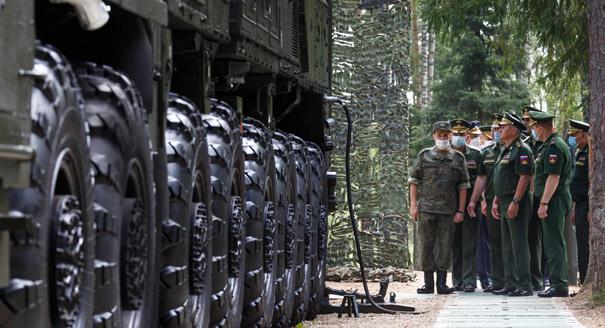The limits on nuclear weapons set by the New START treaty between Russia and the United States are due to expire in 2021. With bilateral relations between the two countries at an impasse, what are the options for keeping the nuclear arms control agenda alive?
One option is the U.S. proposal to extend the 2010 New START for five more years beyond 2021. This is a backup plan if a new treaty is not signed before then, and this option is actually mentioned in the text of the treaty.
According to New START, Russia and the United States are required to limit their strategic weapons to no more than 700 deployed delivery vehicles and 1,550 warheads. In his June 2013 speech in Berlin, Barack Obama proposed a new treaty with Russia that would reduce strategic weapons by approximately one-third. Russian and American strategic weapons could be limited to 1,000 warheads and 500 deployed delivery vehicles.
Washington’s next proposal to further reduce strategic weapons came in January 2016. It may have been triggered by the joint statement issued by the Nuclear Threat Initiative (NTI) and the International Luxembourg Forum on Preventing Nuclear Catastrophe in Washington in early December 2015.
This proposal drew a rather sharp negative response from Moscow. Russia cited numerous reasons for its inability to negotiate with the United States: the need for multilateral agreements with other nuclear powers, the ongoing expansion of the global and European missile defense system by the United States, the potential threat of a disarming high-precision non-nuclear strike against Russian nuclear forces, the militarization of space. Finally, Moscow mentioned the sanctions imposed by the West and the United States in particular on Russia because of the Ukraine crisis.
Let’s leave aside for a moment the validity of the first three reasons advanced by Moscow. Extending the treaty seems like a reasonable course of action if we admit that serious negotiations between the two countries are impossible in the immediate future. Crucially, if the treaty is no longer in force, that would eliminate the legal framework that has allowed both parties to effectively monitor mutual treaty obligations for decades.
Currently, the parties are informed about the types and composition of each other’s strategic arms, deployment areas, the number of deployed and undeployed delivery vehicles and their warheads, as well as any changes to be made in the near future. New START provides for 18 annual on-site inspections of the parties’ land, sea, and air nuclear bases. Both sides also exchange up to 42 notifications a year of changes at their strategic nuclear arms sites.
Lack of information about the condition of the opponent’s armed forces generally leads to the other side exaggerating their number and quality, which in turn prompts that side to increase its own strength to a level at which it could make an appropriate response. This puts everyone on the road to an uncontrollable armed race. This is especially dangerous when strategic nuclear weapons are involved, since it will eventually undermine the very concept of strategic stability as we understand it, and this is precisely why it would be prudent to extend New START for a further five years until 2026.
Yet before the current treaty expires in 2021, it would be even more beneficial to draft and sign a new treaty between Russia and the United States, reducing the parties’ strategic arms levels to the numbers cited above.
Considering the many obstacles that stand in the way of a new treaty, we need to take into account several factors.
First, multilateral negotiations on arms reductions are likely to run into virtually insurmountable difficulties, as all other nuclear powers except for Great Britain possess both strategic and non-strategic nuclear weapons. Non-strategic weapons are not subject to conventional means of control, since their delivery vehicles are dual-purpose, of multiple types, and cover a large number of deployment areas.
And yet step-by-step progress toward constructive consultations on nuclear arms reductions and transparency measures is possible.
As a first step, it would be appropriate for Great Britain and France to adopt in part the transparency system used by Russia and the United States under New START. That would entail regular notifications about the composition, number, and types of nuclear weapons; the locations of nuclear weapons production facilities; the start and end of nuclear weapons production processing; the addition or removal of weapons from nuclear forces; as well as other notifications previously used by Russia and the United States. It’s possible that China might later join this regime, although for now it remains the least transparent nuclear power of the five official members of the nuclear club.
In the current environment, these measures are the most that can be realistically accomplished when it comes to multilateral control over nuclear weapons. But Russia and the United States have to take the initiative to start a dialogue on these issues—something that now seems impossible when their bilateral relations are in such a parlous state.
It also needs to be taken into account that, as Vladimir Putin said in September of last year at the Army-2015 Forum, Russian intercontinental ballistic missiles can penetrate the most technologically advanced missile defense systems. Military experts agree that a high-precision non-nuclear strike against Russian nuclear installations would trigger a retaliatory strike. These two factors should not stand in the way of negotiations on strategic arms reductions.
Both sides have made mistakes in the past. Washington breached the 2002 declaration, which required cooperation with Moscow on missile defense. For its part, Moscow insisted on an unrealistic guarantee that the U.S. missile defense system would not be aimed at Russian nuclear forces. Admitting these mistakes would help to bridge the gap between the parties on this fundamentally important issue.
This article originally appeared in Russian in Nezavisimaya Gazeta, on August 23, 2016.
